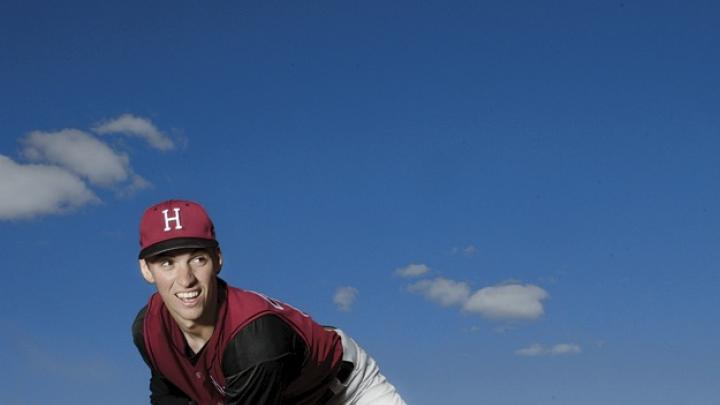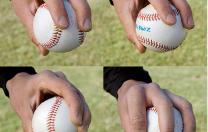As a boy growing up in the Queen City, Brent Suter ’12 had an idol: the Cincinnati Reds’ Ken Griffey Jr., the speedy, power-hitting center fielder who retired last year after 22 seasons with 630 home runs, and who is a lock for the Hall of Fame. Like Griffey, Suter graduated from Archbishop Moeller High School, a parochial school that is a statewide athletic powerhouse. “I liked Junior’s [Griffey’s] swing, his ability to make plays in the outfield,” Suter says. “He seemed relaxed, just a really cool guy.” Suter’s Harvard uniform number is 24, the number Griffey wore when he played for the Seattle Mariners at the start of his career.
Today, however, Suter looks to other role models: Randy Johnson, Andy Pettite, and Cliff Lee—all elite left-handed pitchers. A six-foot, five-inch, 215-pound southpaw, Suter has had considerable success retiring collegiate batsmen. In its preseason forecast, College Baseball Insider website named him the Ivy pitcher whom hitters least want to face and ranked him among the league’s top three starters. Last year, Suter was one of only two starting pitchers named to the all-Ivy First Team, and in one sparkling 33-inning stretch, he went a league-best 4-0 with one save and a 3.55 earned run average (ERA), while striking out 33 batters. Left-handed hitters were almost helpless against him, recording only two hits in 24 at-bats for an .083 batting average. Understandably, he still cherishes a dream he’s had since childhood: playing in the majors.
There’s currently one Harvard-educated pitcher in the big leagues: right-handed reliever Frank Herrmann ’06, who had a creditable 2010 rookie year with the Cleveland Indians, posting a 4.03 ERA across 40 appearances. A generation ago, southpaw Jeff Musselman ’85 (see “The Dow of Professional Sports,” September-October 2001, page 39) pitched five seasons for the Blue Jays and Mets from 1986 to 1990. The Crimson has sent only five players to the majors since 1943, and only one Harvardian, infielder Eddie Grant, A.B. 1906, LL.B. 1909, played in a World Series, alongside Christy Mathewson and Jim Thorpe for the New York Giants in 1913 (see “Soldier, Scholar, Athlete,” November-December 1993, page 83).
Suter throws a fastball, change-up, and curve. The lefty’s heater typically zips in at 88 or 89 miles per hour and tops out in the 90 to 91 mph range. He’s getting better velocity with age, as he grows stronger and improves in stamina; this allows him to maintain the pop on his fastball throughout a game. “I’m a late bloomer,” he says, explaining that he arrived at Harvard as a 175-pound string bean, but has added about 40 pounds thanks to natural growth and weight work. His height provides leverage and increases the whip of his throwing arm, and simply releasing the ball one or two feet nearer the plate is worth another one or two miles per hour. And he works on mechanics, aiming to keep batters from seeing the ball until it is leaving his hand: that diminishes the hitter’s reaction time, making a pitcher “sneaky fast.”
Actually, Suter throws two kinds of fastball, the two-seam and four-seam, differentiated by his grip on the ball (see “A Pitcher’s Grips.”) The four-seamer travels straighter and a couple of miles per hour faster: it’s a good pitch to try when a batter has two strikes, because the extra gas can blow the ball by a hitter for a strikeout. And Suter is a strikeout pitcher: last year he fanned 47 in 49.2 innings pitched, while posting a 4-2 record with a 5.26 ERA. As a freshman he whiffed 53 in as many innings.
Nonetheless, the ability “to throw off-speed pitches for strikes is a big separator,” Suter says. Any baseball hurler worth his salt can pound the strike zone with fastballs, but if that’s his only pitch, hitters will begin to “sit on” (expect) the fastball and tee off on it. Hence the importance of off-speed pitches like Suter’s curve and change-up, which move differently from the fastball and arrive at the plate at a different speed. His “out pitch” is his change-up: thrown with the same motion as the fastball, but with a grip that nestles the ball in the palm of the hand, the change-up may travel eight to 12 mph slower than the fastball, fooling the batter into swinging ahead of the pitch.
Suter gets plenty of outs throwing a change on, say, an 0-1 count, making the batter top the ball for a groundout. When hitters put the ball in play, Suter gets about half his outs from groundouts and half from fly balls. “You strive for ground-ball outs,” he says. “Especially with metal bats [which make balls carry farther than wooden ones], you want to keep the ball out of the air. And you always want to miss the barrel of the bat.”









